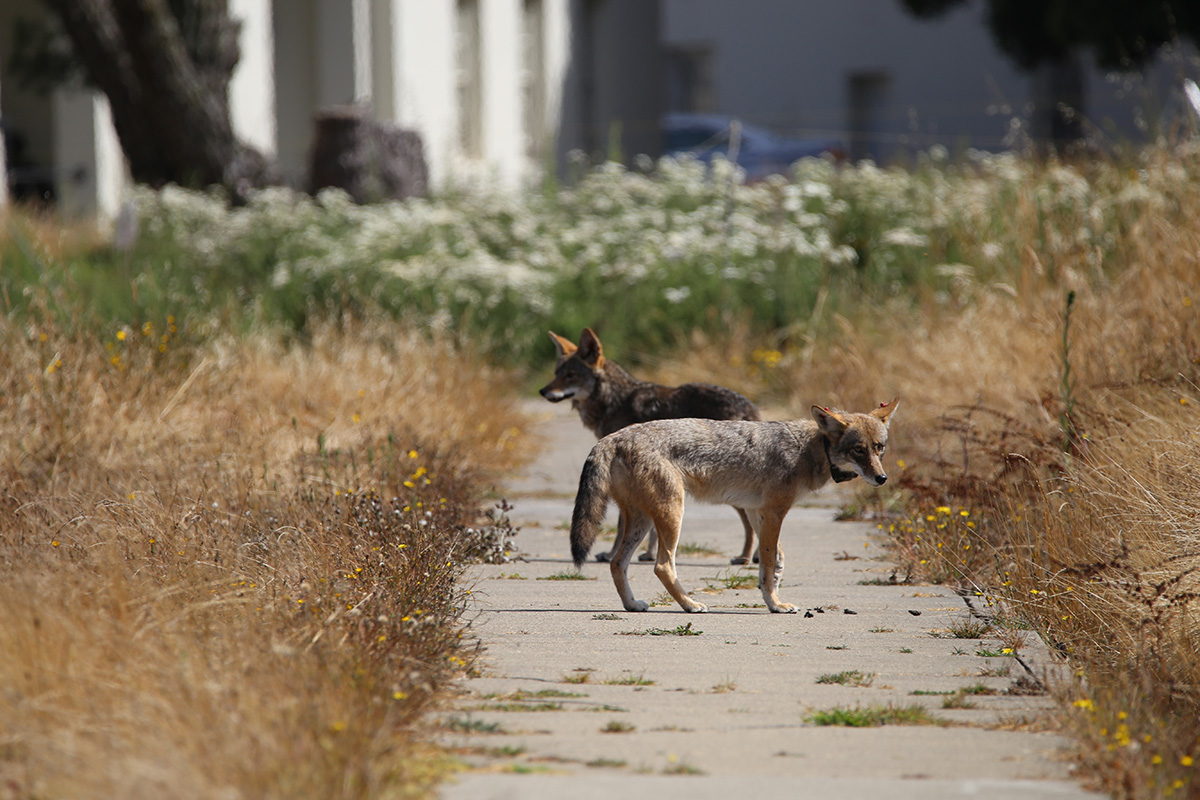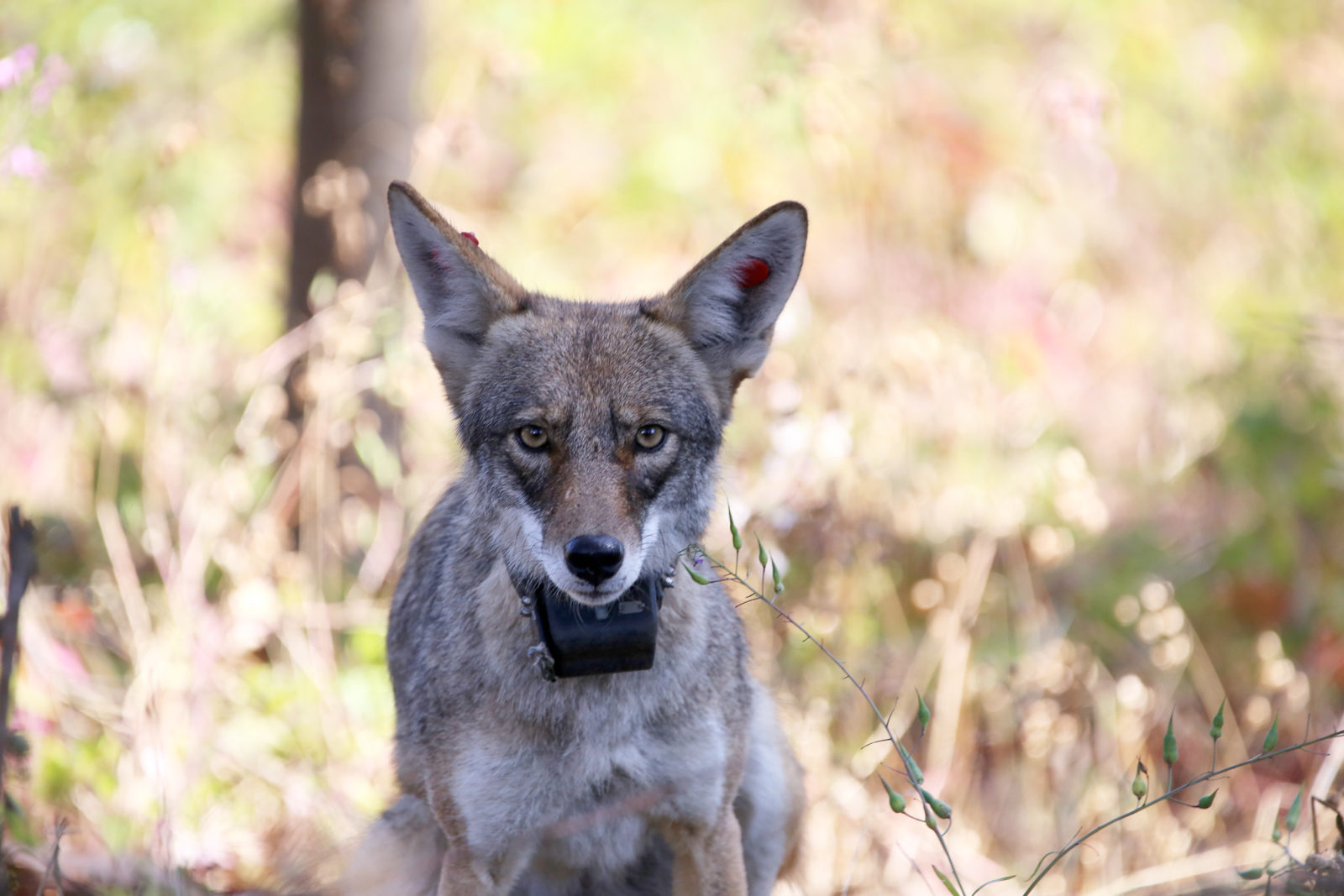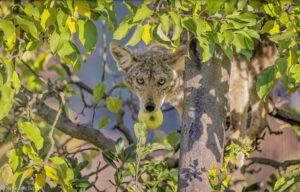Bay Nature last covered the return of coyotes to the Presidio, and ecologists’ efforts to track them, in the January 2018 magazine.
We don’t yet know her origin story or how she made it here, but the Presidio in San Francisco has a new top dog.
Presidio Trust ecologist Jonathan Young, who has tracked coyotes in the urban national park for four years, says that an adult female coyote he hadn’t seen before arrived in the Presidio in January 2019. Perhaps she came from Santa Cruz. Perhaps she had been born in the Presidio many years earlier and returned. Either way, he was able to put a tag and collar on her and follow her as she left the park and started to wander. For eight months she went up and down the Peninsula and around the city: to Colma, Brisbane, Bernal Heights, San Bruno Mountain, Lake Merced, USF, back to Colma.
Then one day last summer she showed up in the Presidio again, this time with a mate. There the pair seem to have suddenly decided to stay put.
Shortly after the coyote’s return to the Presidio in August, security camera footage from the loading dock of Arguello restaurant in the park captured a ferocious battle between the new female and the park’s longtime resident alpha female. When it was over, the new coyote pair stuck around and the old one had gone. For the last few months, Young said, he’s watched the new pair aggressively marking territory, while the former alpha female retreated to Golden Gate Park and Lands End, and then to Pacifica, where she was killed by a car in early January. The former alpha male hasn’t been spotted since last summer either, Young added, and he assumes it has also died.
“So basically what happened over the last few months is regime change in the Presidio,” Young said. “We have a new alpha pair in the Presidio. It’s uncertain how this new pair will take to their kingdom.”

For Young and other scientists, the new pair represents an opportunity to learn much more about urban coyotes. He’s taken hair and whisker samples, which they can analyze to answer questions about where the coyote came from, and possibly how closely related it is to the Presidio’s other coyotes. New techniques will allow scientists to also figure out what the coyotes are eating — traditional analyses involve dissecting scat and looking for bones, which doesn’t help, Young said, if the coyotes are mainly scavenging boneless burritos from the park’s trash cans.
Tali Caspi, a graduate student in ecology at UC Davis who plans to analyze the Presidio coyotes’ diet, said that scientists have studied urban coyote diets elsewhere, and found that they vary, particularly when it comes to human food. Using DNA barcoding studies of the coyote scat and stable isotope analysis of hair samples, Caspi said, she’ll be able to see more clearly what these coyotes eat. (Human food, she said, shows up as a carbon signature reflecting all the corn in our diet.) Future projects could then look at other coyotes across San Francisco, she said, to get an idea of how urban landscape characteristics influence what coyotes eat. Coyotes that dine regularly on human food presumably come into conflict more often with people, so better maps could improve relationships with San Francisco’s wild apex predator.
“Across North America there have been increases in incidents or interactions between humans and coyotes,” Caspi said. “No one is quite sure what’s behind that increase. Even though we have these guesses, but it’s still really unclear. What drives human-coyote conflict, what makes a nuisance animal, can we predict which coyotes are more likely to interact with people, what’s the ecology of coyote conflict in San Francisco and can we generalize to cities?”

Young said he assumes too that the pair will breed this spring, so he’s watched for signs that the female is building a den. Data from the last alpha pair allowed the Presidio to alert dog owners to avoid certain areas of the park, and he’s hoping to do the same again. “We put so much time into studying the old pair, it was starting to work really well in terms of managing dog-coyote conflict,” Young said. “If you have one collared coyote, the alpha female is the one to have.”
There might be other coyotes in the park, the offspring of the previous alpha pair, Young said, but he’s not sure how many. Although his research has shown that only one family of coyotes at a time lives in the park, he’s counted as many as seven individuals in the family. One young female, who he tagged in 2018, seemed to have briefly coexisted with the new alpha — or at least, Young said, he saw them in the same vicinity at the same time without an apparent fight. But the young coyote’s collar stopped working soon afterward, and based on reports from elsewhere in the city, Young said he thinks the young coyote has now moved out, perhaps to Lafayette Park.
“We don’t really know their relatedness, and how coyotes would socially mingle with distantly related cousins or siblings,” Young said.





